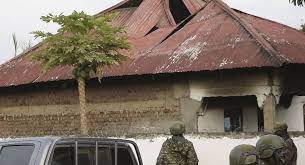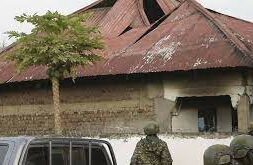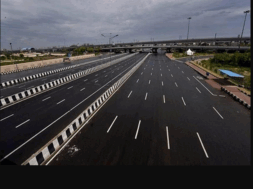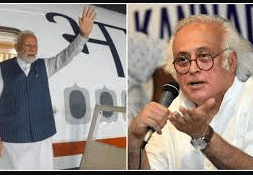
41 People Including 38 Students Massacred in Uganda in Militant Attack
Manas Dasgupta
NEW DELHI, June 17: In one of the worst militant attacks on innocent students, at least 41 persons including 38 students, were burned, shot or hacked to death after suspected rebels attacked a secondary school near the border with Congo, the local mayor said on Saturday.
Ugandan authorities who recovered the bodies of 41 people said at least six people were also abducted by the rebels, who fled across the porous border into Congo after the raid on Friday night.
The Ugandan military authorities blamed the massacre at Lhubiriha Secondary School in the border town of Mpondwe on the Allied Democratic Forces, a shadowy extremist group with ties to the Islamic State, which has been launching attacks for years from bases in volatile eastern Congo.
The victims included the students, one guard and two members of the local community who were killed outside the school, Mpondwe-Lhubiriha Mayor Selevest Mapoze said. Mapoze said some of the students suffered fatal burns when the rebels set fire to a dormitory and others were shot or hacked with machetes.
The army said it was pursuing militants from the Allied Democratic Forces (ADF) after the cross-border raid late Friday on a secondary school in Mpondwe in Kasese district near the Democratic Republic of Congo.
Investigators said dormitories were set alight and students cut down with knives in a brutal late-night assault by ADF, which is one of the deadliest groups active in DR Congo’s strife-torn east. “Unfortunately, 41 bodies have been discovered and conveyed to Bwera hospital mortuary,” Uganda military spokesman Felix Kulayigye said in a statement, referring to a town near where the attack occurred.
Eight people were injured while six others were kidnapped and taken by the attackers toward Virunga National Park, which straddles the DR Congo border, he added. “UPDF embarked on pursuing the perpetrators to rescue the abducted students.”
It was the deadliest attack in Uganda since twin bombings in Kampala in 2010 killed 76 in a strike claimed by the Somalia-based Al-Shabaab group.
The raid, which happened around 11:30 p.m., involved about five attackers, the Ugandan military said. Soldiers from a nearby brigade who responded to the attack found the school on fire, “with dead bodies of students lying in the compound,” Kulayigye said.
That statement cited 47 bodies, with eight other people wounded and being treated at a local hospital. Ugandan troops are “pursuing the perpetrators to rescue the abducted students” who were forced to carry looted food toward Congo’s Virunga National Park, it said. The school, co-ed and privately owned, is located in the Ugandan district of Kasese, about 2 kilometers from the Congo border where ADF is primarily active and has been accused of killing thousands of civilians since the 1990s.
Joe Walusimbi, an official representing Uganda’s president in Kasese, said some of the victims “were burnt beyond recognition.” Winnie Kiiza, an influential political leader and a former lawmaker from the region, condemned the “cowardly attack” on Twitter. She said “attacks on schools are unacceptable and are a grave violation of children’s rights,” adding that schools should always be “a safe place for every student.”
The ADF has been accused of launching many attacks in recent years targeting civilians in remote parts of eastern Congo. It rarely claims responsibility for attacks. The ADF has long opposed the rule of Ugandan President Yoweri Museveni, a U.S. security ally who has held power in this East African country since 1986.
The group was established in the early 1990s by some Ugandan Muslims, who said they had been sidelined by Museveni’s policies. At the time, the rebels staged deadly attacks in Ugandan villages as well as in the capital, including a 1998 attack in which 80 students were massacred in a town not from the scene of the latest attack.
A Ugandan military assault later forced the ADF into eastern Congo, where many rebel groups are able to operate because the central government has limited control there. The group has since established ties with the Islamic State group.
In March, at least 19 people were killed in Congo by the suspected ADF extremists. Ugandan authorities for years have vowed to track down ADF militants even outside Ugandan territory. In 2021, Uganda launched joint air and artillery strikes in Congo against the group.
According to a police report, police and military units were alerted to a “big attack” at Lhubiriha Secondary School in Mpondwe at around 11:00 pm (2000 GMT) on Friday evening. “On arrival the school was found burning and the dead bodies of students were found lying in the compound and the school’s food store broken into” with items missing, the report stated.
The school is less than two kilometres (1.2 miles) from the border of DR Congo, Major General Dick Olum told AFP intelligence suggested the presence of the ADF in the area at least two days before the attack, and an investigation would be needed to establish what went wrong.
He said it appeared the attackers had detailed information about the school. “They knew where the boys and girls’ dormitories resided,” said Olum from Mpondwe. “This is why the rebels locked the boys’ dormitory and set it on fire. The rebels did not lock girls’ section and the girls managed to get out, but they were cut with machetes as they ran for safety, and others shot.”
He said some of the bodies were burned beyond recognition and DNA testing would be required to identify them. “We have called for more firepower, planes to help in the rescue operation of those abducted, and locating the rebel hideouts for military action,” he said.
The rebels fled toward Virunga, a vast expanse on the border with Uganda and Rwanda and a globally renowned sanctuary for rare species, including mountain gorillas. But militias — of which dozens are active in the mineral-rich eastern DR Congo — also the use the park as a hideout.
Originally made up of mainly Muslim Ugandan rebels, ADF gained a foothold in eastern DR Congo in the 1990s. Since 2019, some ADF attacks in eastern DR Congo have been claimed by the Islamic State group, which describes the fighters as a local offshoot, the Islamic State Central Africa Province. ADF attacks in Uganda are less common and the toll from Friday’s attack is the worst in many years by any group.
It is not ADF’s first attack on a school in Uganda. In June 1998, 80 students were burnt to death in their dormitories in an ADF attack on Kichwamba Technical Institute near the border of DR Congo. More than 100 students were abducted.
Uganda and DR Congo launched a joint offensive in 2021 to drive the ADF out of their Congolese strongholds, but the measures have so far failed to end the group’s attacks. In March this year, the United States announced a reward of up to $5 million for information leading to the capture of the ADF’s leader.
Winnie Kiiza, an influential political leader and a former lawmaker from the region, condemned the “cowardly attack” on Twitter. She said “attacks on schools are unacceptable and are a grave violation of children’s rights,” adding that schools should always be “a safe place for every student.”
The ADF has been accused of launching many attacks in recent years targeting civilians in remote parts of eastern Congo. It rarely claims responsibility for attacks. The ADF has long opposed the rule of Ugandan President Yoweri Museveni, a U.S. security ally who has held power in this East African country since 1986.
The group was established in the early 1990s by some Ugandan Muslims, who said they had been sidelined by Museveni’s policies. At the time, the rebels staged deadly attacks in Ugandan villages as well as in the capital. A Ugandan military assault later forced the ADF into eastern Congo, where many rebel groups are able to operate because the central government has limited control there.














